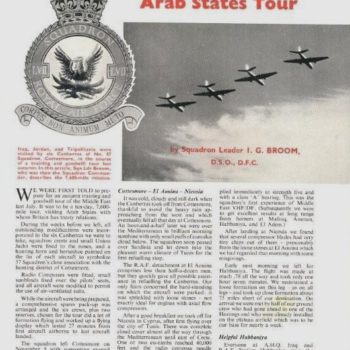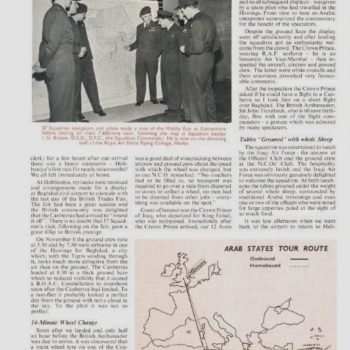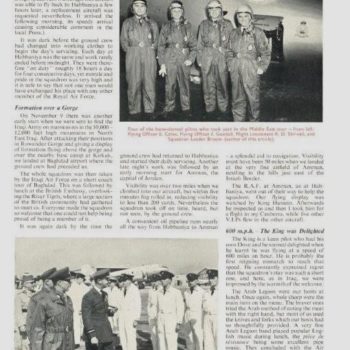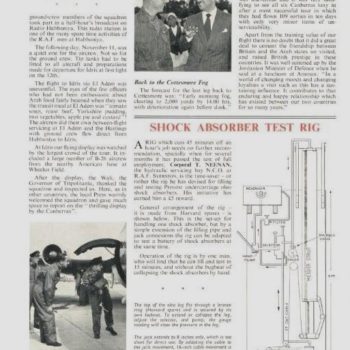57 Squadron - 1945-1959 - Post-WWII Bomber Force
Disbanded on 25 November 1945, 57 Squadron re-formed the following day as 103 Squadron’s Avro Lincoln Flight was re-numbered as 57 Squadron. In May 1951 the squadron converted to Boeing Washington (B29) aircraft, before entering the jet age in May 1953 when it re-equipped with the English Electric Canberra. The squadron disbanded again on 9 December 1957
All in Day’s Work – Fly To East German Border, Engine Failure, Bail Out, Crash Land and Celebrate in Paris!
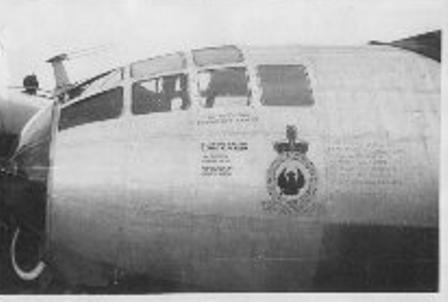
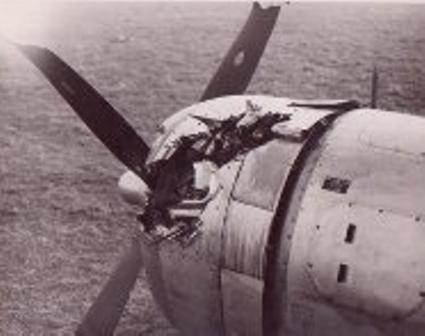
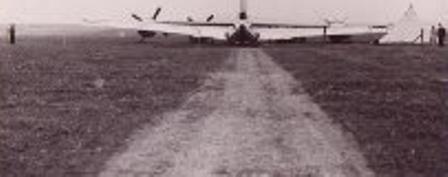
As this story from Air Gunner Stanley Griffiths-Jones tells, flying during the Cold War standoff between the East and West had its moments of excitement. As a National Service Air Gunner Stan had converted onto the B-29 Washington with a reformed 57 Squadron at Marham and was then posted with the Squadron to Waddington.
On 29 September 1951, the crew of 57 Squadron B-29 Washington WF-555 was tasked to fly on a NATO exercise to test western defences. Flying as a ‘standby’ crew member, Stan joined captain Flt Lt Lang and his crew and flew to the East/West German border, suffering problems with the constant speed unit (CSU) on the inner starboard engine. On the crews’ return over France the engine "ran-away" and the propeller sheared off and sliced through No 4 engine. The aircraft lost height from about 20,000 feet and on instructions from the skipper, three of the crew Flt.Lts Ford and Allison, together with Stan bailed out through the bomb doors. All three landed safely and were re-united with rest of the crew unhurt after the plane had safely crash-landed at a disused airfield near Amiens.
The crew was entertained that night by French army officers at a night club and was taken the following day to the British embassy in Paris, where they spent a great week-end, with lots of brandy and beer being consumed to celebrate their good fortune. A French army truck then took them to Soisson from where they were flown by an Avro Anson to RAF Benson to be met by the Waddington Station Commander, Gp Capt Gus Walker who had flown down to pick them up and return the crew back to base. The other members of the crew apart from those mentioned above were Flt Lt Conley (co-pilot), Flt Sgt Martin (navigator), Sgt Holt and Sgt Pringle.
As a result of this adventure Stan became a member of the Caterpillar Club having used an Irvine parachute.
National Service Memories
The story of the National Serviceman after the end of World War II is often overlooked, but those were pivotal days in the development of today’s RAF. It was a time of rapid technological development, with the jet engine, and a growing demand for private trans-continental air travel. And it was a period of huge upheaval globally, as the world struggled to rebuild and the British Empire began to shrink.
Patrick O’Leary was called up for his National Service in July 1951 and after training as a bomb armourer (not a very exciting job he says) he was posted to RAF Waddington in January 1952 to join 57 Squadron. There, he recalls that the station seemed to be dominated by Americans and that Lincolns and Washingtons filled the dispersals. He reckons that they didn’t do much work and remembers sitting “on a shelter bank with a few more irks when we heard the King had died.”
As was typical of the period, squadrons and personnel moved around a lot, as new aircraft came into service and the number of active airfields reduced. So it was that 57 Squadron and Patrick moved to RAF Coningsby with the B-29 Washington.
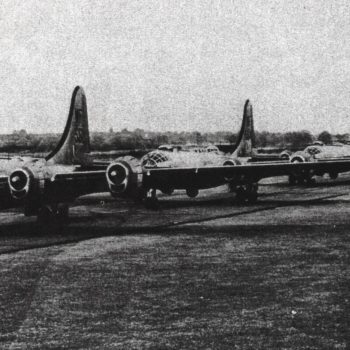
Washingtons of 57 Squadron taxi out at RAF Coningsby, 1952
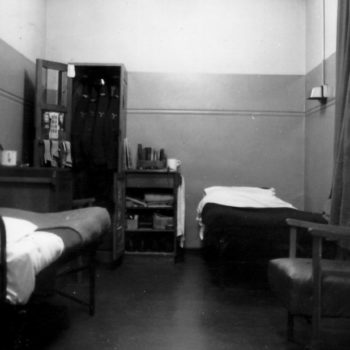
Patrick’s Bunk – RAF Coningsby, 1952
Patrick recalls with great fondness meeting Group Captain Gus Walker, a ‘pure gentleman’ who had time for everyone, and who had himself lost his right arm during a daring rescue attempt, and his successor, Group Captain Willy ‘Tirpitz’ Tate.
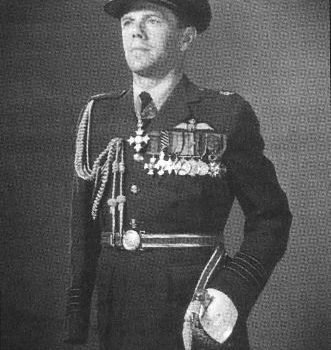
Group Captain ‘Gus’ Walker
(retired Air Chief Marshal Sir Augustus Walker GCB CBE DFC AFC MA)
Leaving 57 Squadron, Patrick moved into the bomb dump at RAF Coningsby, and he was fortunate to have the chance to ‘take a flip’ in a 15 Squadron Washington. Clambering through the tunnel over the bomb doors, Patrick’s chute came unpacked, so the crew calmly told him to go and get another before he took the bomb aimers place in the nose for a memorable training run over The Wash, watched by his mates from the Bomb Dump.
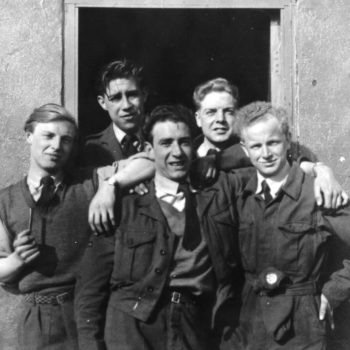
The Bomb Dump Crew, RAF Coningsby, 1952 Patrick O’Leary is back left, LAC Dixon is front left (with pipe)
On 14 August 1952, Patrick witnessed a 92 Squadron Meteor crash just south of Coningsby while practicing for air displays. Patrick stood guard at the crash site and has subsequently re-visited it and the grave of the pilot, Squadron Leader Jack Jagger.
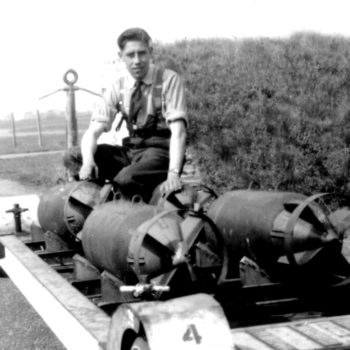
Patrick O’Leary, RAF Coningsby Bomb Dump, 1953
It wasn’t long before more change, with 57 Squadron re-equipping with the Canberra B2 in May 1953. Patrick remained at Coningsby and has fond memories of weekends spent in Boston and at the Gliderdrome. Less pleasant memories involve an incident when one of his colleagues at the bomb dump dropped a 25lb practice bomb while unloading it from a truck. The bomb exploded covering LAC Dixon with burning phosphorous. Despite Patrick and his mates dousing him in a nearby stream, Dixon suffered bad scars to his face.
Leaving the bomb dump, Patrick moved to the Armament Servicing Flight (ASF) Armoury in late-1953 where he fitted cartridges to Canberra ejection seats, and while sat in the pilot’s seat he continued to fantasize about flying again.
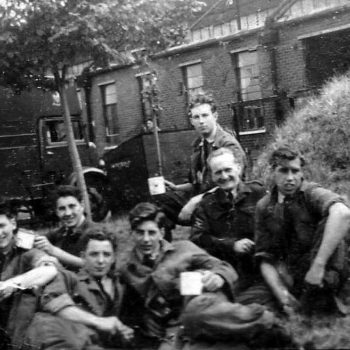
NAAFI Break – ASF Armoury, RAF Coningsby, 1953
Patrick O’Leary is far right, ‘Chief’ Alan Haslock is second from left holding a mug
One of the ‘smarter guys’ he was selected to attend the Queen’s Coronation Parade at RAF Odiham where he enjoyed a couple of days looking around the impressive display of aircraft – he thinks the B29s had been polished with Duraglit!
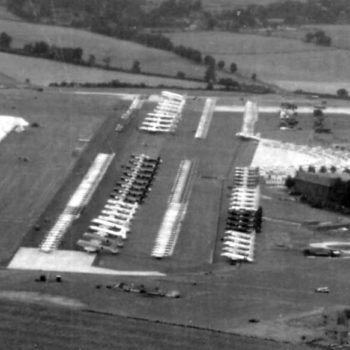
The Queen’s Coronation Parade Aircraft Line-Up – RAF Odiham, 1953
In early-1954, the Coningsby units were packed off to RAF Cottesmore to allow the runways to be re-laid for the arrival of V Force Valiants. This move was to be Patrick’s last in the RAF. He had his 21st birthday do in Stamford and “got sloshed, missed the last bus back to camp, had to walk 14 miles, and was put on a fizza.”
So ended 3 years of National Service which Patrick looks back on as eventful and for which he remains eternally grateful. Patrick continues to be an active member of the National Service (RAF) Association, and maintains his contacts with colleagues from the Washington days.
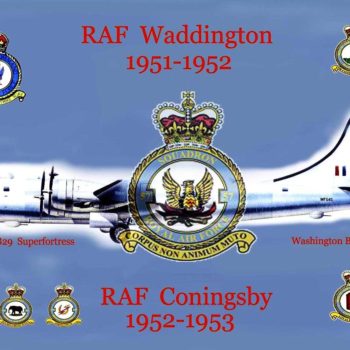
Patrick’s Montage of his time on National Service, presented to 57 & 630 Squadrons’ Association in 2006
He is also a member of the 57 & 630 Squadrons’ Association and remembers meeting the Australian veterans below at East Kirkby in 2006.
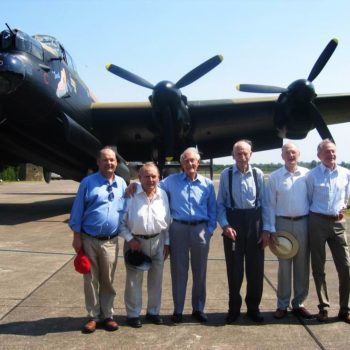
East Kirkby – 2006
(Photo: Patrick O’Leary)
57 Squadron Canberra Tour ofIraq and Jordan and Libya – 1955
In 1955, a detachment of six Canberra aircraft from 57 Squadron was tasked with undertaking a goodwill tour of Iraq, Jordan and Libya. The deployment was led by the then Officer Commanding 57 Squadron, Squadron Leader Ivor Broom DSO DFC** RAF (Later Air Marshal Sir Ivor Broom KCB CBE DSO DFC** AFC RAF and founding President of the 57 & 630 Squadrons’ Association).
Following his return to the UK, Squadron Leader Broom took the time to write up his memories of the tour for ‘Air Clues’, the Royal Air Force flight safety-orientated magazine. That article is reproduced below, and certainly harks back to an era that has now disappeared.
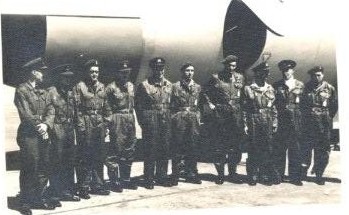
57 Squadron pilots and navigators in front of a Canberra B2 at Habbaniya, Iraq 1955
